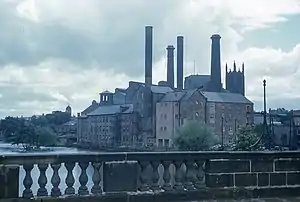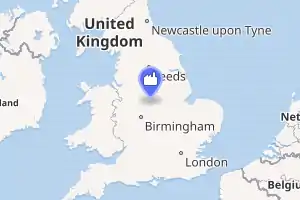Derby power station
Derby power station supplied electricity to the town of Derby and the surrounding area from 1893 to 1969. The power station was built and operated by Derby Corporation and started generating electricity in October 1893. It was located in Silkmill Lane in the town centre adjacent to the River Derwent from which it drew its cooling water. The power station was extended in the 1920s and 1940s. It was closed in 1969 and was subsequently demolished.
| Derby power station | |
|---|---|
 Derby Power Station in 1957 | |

| |
| Country | United Kingdom |
| Location | Derby, Derbyshire |
| Coordinates | 52°55′33″N 01°28′35″W |
| Status | Decommissioned and demolished |
| Construction began | 1892 |
| Commission date | 10 October 1893 |
| Decommission date | 1969 |
| Owner(s) | Derby Corporation (1892–1948) British Electricity Authority (1948–1955) Central Electricity Authority (1955–1957) Central Electricity Generating Board (1958–1972) |
| Operator(s) | As owner |
| Thermal power station | |
| Primary fuel | Coal |
| Turbine technology | Steam driven reciprocating engines and steam turbo-alternators |
| Chimneys | 4 |
| Cooling source | River water |
| Annual revenue | £67,691 (1923) |
| Power generation | |
| Units operational | 1 × 30 MW, 1 × 20 MW, 1 × 10 MW, 1 × 0.5 MW (1950s) |
| Make and model | Parsons |
| Units decommissioned | All |
| Nameplate capacity | 65.5 MW (1950s) |
| Annual net output | 219.7 GWh (1955) |
History
In 1890 Derby Corporation applied for a Provisional Order to generate and supply electricity to the town of Derby, Derbyshire. This was granted by the Board of Trade and was confirmed by Parliament by the Electric Lighting Orders (No. 5) Act 1890 (54 & 55 Vict. c. cxc).[1][2] The Corporation electricity undertaking constructed a power station on a triangular site (52°55'32.6"N 1°28'35.4"W) bounded by Sowter Road, Silkmill Lane and the River Derwent.[3] It had an initial generating capacity of 572 kW.[4] The generating equipment comprised steam driven Browett Lindley engines coupled directly to Siemens dynamos. The supply of electricity commenced on 10 October 1893.[4] In the year ending March 1898 the station sold a total of 350.33 MWh powering 20,418 lamps (each of 8 candle-power). The maximum load on the system was 336 kW, and there was 317 consumers.[4]
Traction current was supplied to the municipal tram system from 1904.[5]
During the First World War British Cellulose refused to take an electricity supply from Derby power station because they were generating electricity on a larger scale and more cheaply than the municipal supply.[6]
New boiler house 1921
A new boiler house was commissioned in 1921, at a cost of £120,000.[7]
Specification
By 1923 the steam plant at the station had a capacity of 260,000 lb/h (32.8 kg/s) and supplied steam to:[8]
- 3 × 2,000 kW steam turbine driven alternating current (AC) generators
- 1 × 4,000 kW steam turbine driven AC generator
- 1 × 7,000 kW steam turbine driven AC generator
- 3 × 750 kW steam turbine driven direct current (DC) generators
These provided a total generating capacity of 2,250 kW.
The station supplied a range of electrical current:[8]
- 3-phase, 50 Hz, alternating current at 230 & 400 Volts
- Single phase, 50 Hz, AC at 200 Volts
- Direct current (DC) at 460 & 230 Volts
Operations
In 1923 the maximum load on the system was 10,138 kW, and there was a connected load of 28,572 kW. The power was sold for the following uses:[8]
| User | Usage MWh | ||
|---|---|---|---|
| 1921 | 1922 | 1923 | |
| Lighting and domestic | 2267.98 | 2425.11 | 2818.38 |
| Public lighting | 204.30 | 175.18 | 200.25 |
| Traction | 1709.29 | 1679.77 | 1714.70 |
| Power | 15,254.42 | 11,598.29 | 14,402.05 |
| Total | 19,435.99 | 15,878.35 | 19,135.38 |
The sale of electricity provided an income to the Corporation of £39,691 in 1923. The surplus of revenue over expenses for generating electricity was £67,509.[8]
New extensions to the plant were built in the late 1920s.[9] The official opening of the extended site on the south side of Silkmill Lane took place on 28 March 1930.[10]
Derby power station and electricity policy
Under the terms of the Electricity (Supply) Act 1926 (16-17 Geo. 5 c. 51)[11] the Central Electricity Board (CEB) was established.[12] The CEB identified high efficiency ‘selected’ power station that would supply electricity most effectively; Derby was designated a selected station. The CEB also constructed the national grid (1927–33) to connect power stations within a region.[12]
It was noted in the inter-war period that all the streets in many prosperous Southern towns and in some Northern towns such as Birkenhead, Derby and Hull had been wired for electricity.[6]
Upon nationalisation of the British electricity supply industry in 1948 under the provisions of the Electricity Act 1947 (10-11 Geo. 6 c. 54)[13] the Derby electricity undertaking was abolished, ownership of Derby power station was vested in the British Electricity Authority, and subsequently the Central Electricity Authority and the Central Electricity Generating Board (CEGB).[12] At the same time the electricity distribution and sales responsibilities of the Derby electricity undertaking were transferred to the East Midlands Electricity Board (EMEB).[13]
Nationalised power station
Specification
The plant installed by the mid-1950s comprised:[14]
- Boilers
- 3 × 45,000 lb/h (5.67 kg/s), Babcock & Wilcox pulverised coal-fired boilers, supplying steam at 310 psi at 710°F to 750°F (21.4 bar at 377 to 399°C).
- 2 × 60,000 lb/h (7.56 kg/s) International Combustion pulverised coal-fired boilers, steam conditions as above.
- 4 × 110,000 lb/h (13.86 kg/s) International Combustion pulverised coal-fired boilers, steam conditions as above.
These boilers had a total steam evaporative capacity of 695,000 lb/h (87.6 kg/s). The boilers fed the following generating plant:[14]
- Generating plant
- 1 × 30 MW Parsons turbo-alternator operating at 33 kV
- 1 × 20 MW Parsons turbo-alternator operating at 6.6 kV
- 1 × 10 MW Parsons turbo-alternator operating at 6.6 kV
- 1 × 5.5 MW Parsons turbo-alternator operating at 6.6 kV
These machines had a total generating capacity of 65.5 MW.[14]
Incident
An engineer was killed at the power station in November 1951. An inquest found that an error of judgement by engineers undertaking an electricity switching operation caused an explosion which killed a shift engineer. The accident could have been prevented by a transformer switch but this could not be delivered for two years.[15]
Operating details of the station over the period 1946–63 were as follows:[14][16][17][18][19]
| Year | Running hours (or load factor %) | Output capacity MW | Electricity supplied GWh | Thermal efficiency % |
|---|---|---|---|---|
| 1946 | (46.4 %) | 230.9 | 21.87 | |
| 1954 | 6112 | 62 | 201.00 | 21.01 |
| 1955 | 6584 | 62 | 219.66 | 21.03 |
| 1956 | 6120 | 62 | 218.22 | 20.87 |
| 1957 | 6006 | 62 | 189.52 | 20.32 |
| 1958 | 5199 | 62 | 178.64 | 20.78 |
| 1961 | 25.3 % | 56 | 130.81 | 19.35 |
| 1962 | 31.9 % | 56 | 156.39 | 19.92 |
| 1963 | 30.35 % | 39 | 148.88 | 19.87 |
| 1967 | 9.4 % | 47 | 38.9 | 17.80 |
The output capacity data demonstrates how machinery was gradually decommissioned.
Closure
The oldest part of Derby power station, north of Silkmill Lane, closed in 1963 and was demolished.[10] The original site retains a connection with electricity as the location of the operational 132 kV Silk Mill substation. The remainder of the station, south of Silkmill Lane, operated until 1969 when it closed.[7] The plant, including the four chimneys, was demolished over the period November 1971 to February 1972.[10]
See also
References
- "Local Acts 1890". legislation.co.uk. Retrieved 3 August 2020.
- "Derby power station and Silk Mill 1890s". pinterest. Retrieved 3 August 2020.
- Ordnance Survey, 25 inch map Derbyshire L.9 (Chaddesden; Derby) Revised: 1899, published: 1901.
- Garcke, Emile (ed) (1898). Manual of electrical undertakings 1898–99. London: P. S. King and Son. pp. 166–168.CS1 maint: extra text: authors list (link)
- "Electric Trams in Derby". photo-sleuth. 14 May 2009. Retrieved 3 August 2020.
- Hannah, Leslie (1979). Electricity before Nationalisation. London: Macmillan. pp. 174, 210. ISBN 0333220862.
- "Derby Power Station and Old Silk Mill Pub". Europeana. Retrieved 3 August 2020.
- Electricity Commissioners (1925). Electricity Supply – 1920–23. London: HMSO. pp. 26–29, 272–277.
- "Derby power station, Derby". picture the past. 1940. Retrieved 3 August 2020.
- "Aerial view of Derby from cathedral tower dominated by power station in 1960s". Derby Telegraph. 1963. Retrieved 3 August 2020.
- "Electricity (Supply) Act 1926". legislation.gov.uk. Retrieved 3 August 2020.
- Electricity Council (1987). Electricity supply in the United Kingdom: a Chronology. London: Electricity Council Electricity supply in the United Kingdom: a Chronology. pp. 45, 60. ISBN 085188105X.
- "Electricity Act 1947". legislation.gov.uk. Retrieved 3 August 2020.
- Garrett, Frederick C. (ed) (1959). Garcke's Manual of Electricity Supply 1958-9 vol. 56. London: Electrical Press. pp. A-50, A-119.CS1 maint: extra text: authors list (link)
- "'Two years to wait for equipment'". The Times. 11 December 1951. p. 2.
- Central Electricity Generating Board, Annual Report and Accounts 1961, London, CEGB
- Central Electricity Generating Board, Annual Report and Accounts 1962, London, CEGB
- Central Electricity Generating Board, Annual Report and Accounts 1963, London, CEGB
- Electricity Commission, Generation of Electricity in Great Britain year ended 31st December 1946. London: HMSO, 1947.